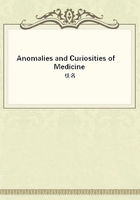
第1章
ANOMALIES and CURIOSITIES of MEDICINEBeing an encyclopedic collection of rare and extraordinary cases, and of the most striking instances of abnormality in all branches of medicine and surgery, derived from an exhaustive research of medical literature from its origin to the present day, abstracted, classified, annotated, and indexed.
by GEORGE M. GOULD, A.M., M.D. and WALTER L. PYLE, A.M., M.D.
PREFATORY AND INTRODUCTORY.
Since the time when man's mind first busied itself with subjects beyond his own self-preservation and the satisfaction of his bodily appetites, the anomalous and curious have been of exceptional and persistent fascination to him; and especially is this true of the construction and functions of the human body.
Possibly, indeed, it was the anomalous that was largely instrumental in arousing in the savage the attention, thought, and investigation that were finally to develop into the body of organized truth which we now call Science. As by the aid of collected experience and careful inference we to-day endeavor to pass our vision into the dim twilight whence has emerged our civilization, we find abundant hint and even evidence of this truth. To the highest type of philosophic minds it is the usual and the ordinary that demand investigation and explanation. But even to such, no less than to the most naive-minded, the strange and exceptional is of absorbing interest, and it is often through the extraordinary that the philosopher gets the most searching glimpses into the heart of the mystery of the ordinary. Truly it has been said, facts are stranger than fiction. In monstrosities and dermoid cysts, for example, we seem to catch forbidden sight of the secret work-room of Nature, and drag out into the light the evidences of her clumsiness, and proofs of her lapses of skill,--evidences and proofs, moreover, that tell us much of the methods and means used by the vital artisan of Life,--the loom, and even the silent weaver at work upon the mysterious garment of corporeality.
"La premiere chose qui s'offre a l' Homme quand il se regarde, c'est son corps," says Pascal, and looking at the matter more closely we find that it was the strange and mysterious things of his body that occupied man's earliest as well as much of his later attention. In the beginning, the organs and functions of generation, the mysteries of sex, not the routine of digestion or of locomotion, stimulated his curiosity, and in them he recognized, as it were, an unseen hand reaching down into the world of matter and the workings of bodily organization, and reining them to impersonal service and far-off ends. All ethnologists and students of primitive religion well know the role that has been played in primitive society by the genetic instincts. Among the older naturalists, such as Pliny and Aristotle, and even in the older historians, whose scope included natural as well as civil and political history, the atypic and bizarre, and especially the aberrations of form or function of the generative organs, caught the eye most quickly. Judging from the records of early writers, when Medicine began to struggle toward self-consciousness, it was again the same order of facts that was singled out by the attention. The very names applied by the early anatomists to many structures so widely separated from the organs of generation as were those of the brain, give testimony of the state of mind that led to and dominated the practice of dissection.
In the literature of the past centuries the predominance of the interest in the curious is exemplified in the almost ludicrously monotonous iteration of titles, in which the conspicuous words are curiosa, rara, monstruosa, memorabilia, prodigiosa, selecta, exotica, miraculi, lusibus naturae, occultis naturae, etc., etc.
Even when medical science became more strict, it was largely the curious and rare that were thought worthy of chronicling, and not the establishment or illustration of the common, or of general principles. With all his sovereign sound sense, Ambrose Pare has loaded his book with references to impossibly strange, and even mythologic cases.
In our day the taste seems to be insatiable, and hardly any medical journal is without its rare or "unique" case, or one noteworthy chiefly by reason of its anomalous features. A curious case is invariably reported, and the insertion of such a report is generally productive of correspondence and discussion with the object of finding a parallel for it.
In view of all this it seems itself a curious fact that there has never been any systematic gathering of medical curiosities. It would have been most natural that numerous encyclopedias should spring into existence in response to such a persistently dominant interest. The forelying volume appears to be the first thorough attempt to classify and epitomize the literature of this nature.
It has been our purpose to briefly summarize and to arrange in order the records of the most curious, bizarre, and abnormal cases that are found in medical literature of all ages and all languages--a thaumatographia medica. It will be readily seen that such a collection must have a function far beyond the satisfaction of mere curiosity, even if that be stigmatized with the word "idle." If, as we believe, reference may here be found to all such cases in the literature of Medicine (including Anatomy, Physiology, Surgery, Obstetrics, etc.) as show the most extreme and exceptional departures from the ordinary, it follows that the future clinician and investigator must have use for a handbook that decides whether his own strange case has already been paralleled or excelled. He will thus be aided in determining the truth of his statements and the accuracy of his diagnoses.
Moreover, to know extremes gives directly some knowledge of means, and by implication and inference it frequently does more.